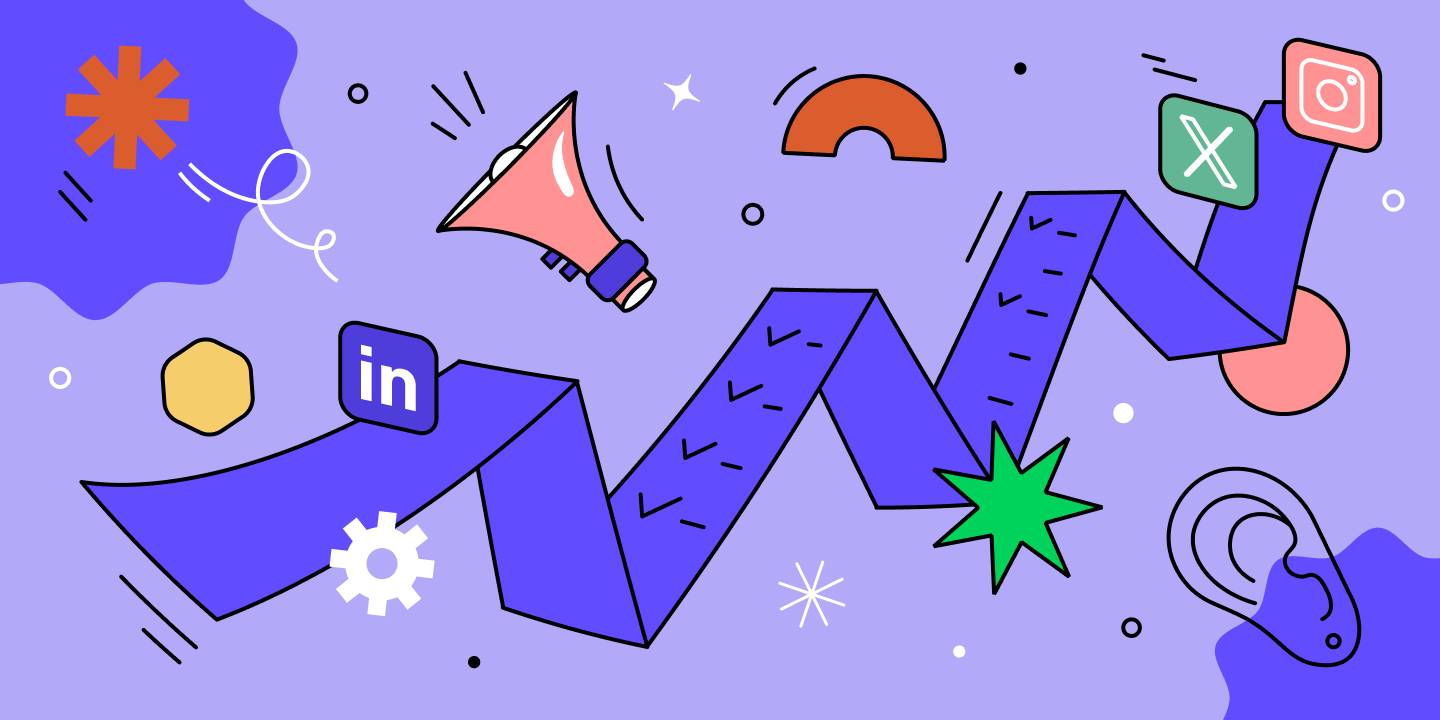Do you really need social listening to see the full scope of your public relations activities? Imagine you saw the impact your strategy has on your brand's reputation, but had no way to prove it without looking at the bigger picture.
Social listening software, like Prowly, helps to examine your brand's presence everywhere people might have conversations about it.
This means you can keep your brand's presence consistent and fruitful everywhere online, knowing your share of voice, engagement, reach, sentiment analysis, and more - and you will learn to do all of this today:
- What is social listening?
- 7 reasons to start using social listening in PR
- Why is social listening important in PR?
- How to do social media listening in PR?
- How does social listening work?
- Social listening vs. social monitoring
- Social listening tips for PR professionals
- Be up to date with a social listening tool
What is social listening?
Social listening is the process of analyzing what your audience thinks of your brand, its products, and the people associated with it. It evaluates the "big picture" by collecting information from online conversations to help draft strategy, gain in-depth data, and spot outliers.
For example, let's say you created a social impact campaign to raise awareness about a particular issue and attached a shareable hashtag to it.
Social listening helps to examine each part of your campaign and show its impact – along with hashtags people might have missed, but mentioned your company; people raising awareness but not tagging your brand at all, or overwhelmingly positive sentiment across certain media platforms, but not others.
Psst! A sneak peek into Prowly's Social Listening:
7 reasons to start using social listening in PR
With all the social media platforms, it's not uncommon for social media listening to take precedence over outlet monitoring at times. Online conversations happen in an instant, unfolding with unparalleled speed which oftentimes surpasses the pace of traditional journalism.
Knowing where the sentiment of online chatter is going allows brands to shift it if necessary, prevent a crisis, or put more budgets into already successful strategies. This is why social media listening software isn't just an add-on – it's a necessity.
1️⃣ Identifying new opportunities
Having a social listening tool will help you connect to your audience and know what they like, and don't like about your brand.
Depending on your industry, you may gain insight into what they think about your business, what issues they'd like to have addressed, and what is working successfully.
Not only will social monitoring help you see the people who advocate for the brand the most, but also come across conversations you might have not been aware of.
For example, if you're running a brand whose target audience is women, maybe a strong advocate has liked several of your posts which makes it easier to reach out and create a meaningful relationship for the future.
2️⃣ Getting real-time social listening mentions
Diving into social media channels is like tapping into a goldmine, but it's important to stay realistic here – monitoring the flood of posts, reactions, hashtags, and trends is a bit much (even for a social media fanatic).
To stay ahead, you need a one-stop shop like a social listening platform to wrangle all of that data, as soon as it appears online.
Comments, perspectives, and ideas travel with the speed of light, especially if you're newsjacking a topic or doing a campaign that has the potential for controversies.
3️⃣ Monitoring competitors
A good competitive analysis without social listening tools is nearly impossible.
Can you imagine jotting down every engagement metric, comment, like, and so on? We're not mathematicians after all, and social monitoring comes in handy when it's time to look at straightforward data.
Set up queries for all of your competitors and compare them with share of voice, engagement metrics, reach, and many others.
That way, you'll know how to rev up your social listening strategy and dial into what the world is saying about your competitors.
4️⃣ Verifying strategy and reputation management
Social listening tools offer a comprehensive understanding of how audiences perceive a brand or campaign – from reshares, to comments, sentiment analysis, and engagement, you can easily validate your strategy and whether or not it's effective.
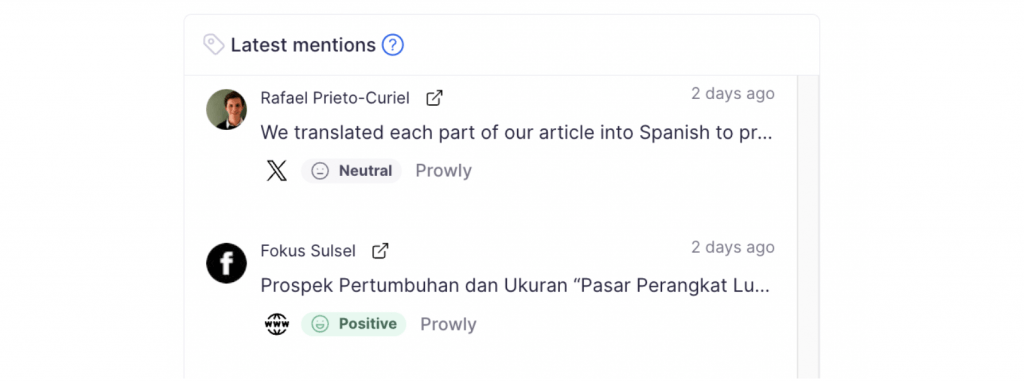
Let's say there's a surge of positive conversations. Then, you know your social media strategy and public relations angles are working well.
But what if there's a negative comment or two, and within minutes the audience is jumping on the bandwagon? What if you didn't predict that?
Being able to foresee the positives and negatives of your strategy is crucial to achieving PR success and altering future plans with responsive approaches that resonate with the dynamic sentiments of your target audience.
For example, with Prowly, you can set up custom notifications and find out about positive, neutral or negative sentiment as it happens.
That way, you can get email notifications including recurring digests and specific alerts:
➡️ Monitor search queries with real-time alerts to prevent a brewing crisis
➡️ Receive daily, weekly or monthly mention summaries straight to your inbox
➡️ Share notifications with stakeholders to show them the impact of your work
5️⃣ Turning mentions into actionable business insights
Online conversations happen in the comments, but customers also go on rants on different forums, including Reddit.
Most of the time, that's where you'll know if a new feature is working, or is it more of a flop in terms of community sentiment.
With a social listening tool, you can track your audience engagement, sentiment, and growth using social media tracking, and see where their happiness or frustrations lie. Then, it's just a matter of handing over that feedback to clients or stakeholders so they can adjust their business strategy.
6️⃣ Showing a full overview of PR activities
Social listening provides a holistic overview of all of your activities – it's like having the big picture right in front of you.
With special tools, you can see and understand how your client's brand is perceived on all different social channels, including social media, forums, industry communities and so on.
7️⃣ Gaining a better understanding of trending topics
Looking for the perfect moment to jump in on a trend?
Too soon, and you'll lose the opportunity to go viral – too late, and you'll be just another brand jumping on the bandwagon.
With a social listening tool, you can create queries using specific keywords and see when they start trending exponentially.
Truth is, you should use social media monitoring to set up alerts for people from your industry who are known to engage in trends, track brands who are your competitors to see what they're up to, track specific hashtags, industry jargon, and so on.
Here's a list of over 15 social listening tools if you're still looking for the best option for your PR agency. Or you can simply check out how you can do it all with Prowly.
And if you'd like to delve a bit deeper into the social listening strategy for PR, check out this article brimming with tips and examples.
Why is social listening important in PR?
🤝 Creating meaningful relationships
Without active social listening, you may miss important media mentions and opportunities to engage in conversations with those who support you the most.
Fostering authentic connections with the audience, stakeholders, and influencers can increase your chances of securing valuable coverage and success in brand reputation management.
Whether you reply to positive sentiment from a regular customer or alleviate a pending crisis with a perfect answer, even the smallest interactions matter. They may not be as memorable to you, but to the other person they may mean a lot.
Without dedicated social media management software, tracking all mentions is increasingly difficult, especially if you're working with a bigger brand or one that has conversations in less-known channels.
💡Explore our latest article on How Social Media Listening Can Increase Customer Advocacy.
👥 Identifying and tracking influencers
Knowing who to target is key to the goals you want to achieve.
Whether your social listening strategy focuses on nano influencers or bigger ones, you should have a plan in place on how to build these relationships effectively.
By using social listening, you can identify:
👉 which influencers are great for your niche,
👉 which ones like it but aren't particularly interested in getting involved in it,
👉 see whose reputation was recently tarnished and won't be a good look for your brand,
👉 as well as see if there are smaller communities of industry-specific influencers you have yet to discover.
💬 Monitoring engagement
In the past, monitoring outlets was more than fine, but then we had an internet boom, and bam – whoever works in public relations had to track mentions in all social media channels as well.
Social listening tools play a huge role in providing actionable insights through data from audience interactions, sentiment trends, and overall engagement across various platforms and campaigns.
For example, if you're working in a political niche and elections are coming up, it's a no-brainer that engagement will predict actual results in the end.
🔎 Providing better insights for stakeholders
We've been fighting to get a seat at the table for a long time, and while over time we're closer and closer, oftentimes stakeholders want to see data to back up our work and strategies.
Numbers are important, but what's more impactful are numbers they actually understand.
The value of social listening data is easy for us to comprehend, but when it comes to clients, managers, and stakeholders, we can't require them to know it all and understand it the way we do.
👉 The best way to display data, in a manner everyone understands, are graphs and visual elements.
The better you can show them what you do, the more you can highlight increases in graphs and higher numbers, and the better they see that ROI in public relations is worthwhile.
🥈 Knowing what competitors are up to
Understanding your competitors is a critical aspect that should be seamlessly integrated into your strategy.
Following their mentions in online outlets and social media, accounts can help you predict their next moves, give insights into what they're doing right now and what your target audience is enjoying, or even measure their share of voice against yours over a period of time.
- Is their audience more tuned in on Twitter, Facebook, or Instagram?
- Are they more responsive to controversial content, or vanilla posts?
Knowing what your competitors are up to can help you identify potential customers, capitalize on the weaknesses of your rivals, help you score more mentions, and more engagement overall. You should also check if your competitors recently moved from Twitter to one of its alternatives, as have many other users.
🔔 Setting up alerts in case of a crisis
With social listening software, you can set up mention alerts to prevent an oncoming crisis.
While using Prowly's social listening tool, you'll be able to set up a query using specific keywords and then get coverage reporting as frequently as you want to – daily, weekly, or monthly.
For unusual spikes, Prowly's social monitoring feature will alert you immediately as they happen, so you can respond to comments or conversations as they happen and protect your brand's reputation.
How to do social media listening in PR?
Never manually, I'll tell you that. Social listening software will allow you to stay organized while tracking mentions of a certain hashtag, your competitors, compare brand presence with charts and more.
Common PR social media listening workflow
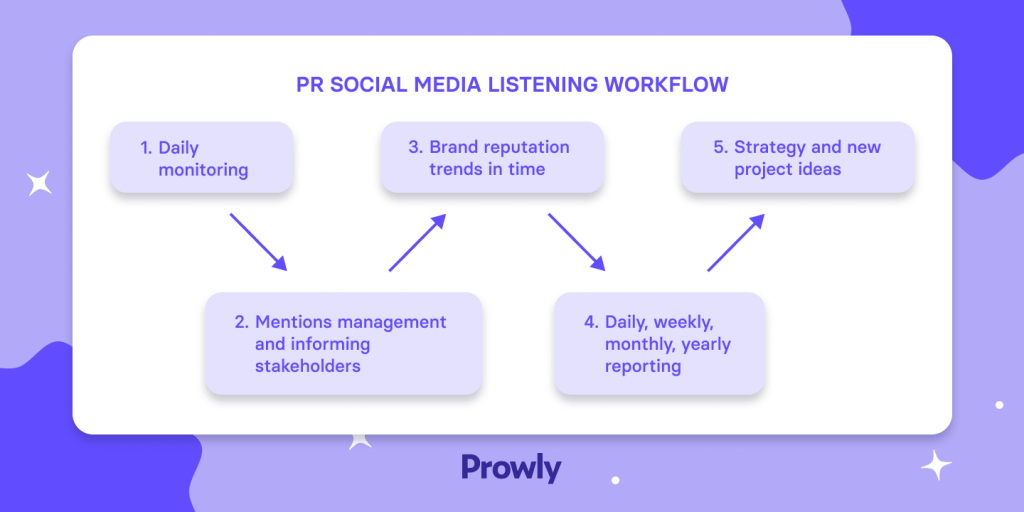
Read on to see what a PR social media listening workflow might look like, one step at a time.
#1 Listen to & monitor social media
📆 How often should I do this? Daily.
A lot can change overnight, so listening in to conversations daily is crucial for top-notch brand reputation management. Whether you send a report to stakeholders each morning, or note it down for an end-of-the-month presentation, it's important to check it every day so you don't miss anything.
With Prowly's social listening feature, you can monitor various online channels and choose from dozens of filters to get the results you're interested in the most.
#2 Manage mentions & inform stakeholders
📆 How often should I do this? It depends
- If you're working in-house, it's more common that you'll be sending daily reports your stakeholders will probably read over morning coffee.
- However, some clients want a monthly or weekly report.
Social listening with Prowly makes it easy to send these reports because you can simply generate a daily, weekly, or monthly report to any email recipient. Think of it as internal relations management – you’re taking care of your clients and supervisors by keeping them up to date.
#3 Spot brand reputation trends
📆 How often should I do this? It depends.
Prowly's Social Media Listening gives access to real-time data, all perfectly distributed across a comprehensive dashboard.
In order to spot trends and dependencies in social listening, it's crucial to assess all sources of information, focus on key numbers, and cut off all the noise with effective filters.
With data analysis, you can optimize social media strategies based on performance metrics and insights.
To spot trends, you need to gather larger amounts of data, but this also depends on the goal of your research. Are you looking for a quick fix or long-term improvements?
👉 To manage a crisis situation, you’ll need to do damage control, and then check if your response is working and if you’ve entered the recovery phase. For that, it’s good to observe brand sentiment every single day.
👉 Is your brand's audience more engaged on the East Coast, and less on the West Coast? Are certain campaigns bringing in more positive sentiment than others? To see how your share of voice is evolving, compare it on a monthly basis.
Those are the numbers that will help you examine your current strategy, and draft new ones in the future.
#4 Use social listening tools to collect insights and report back
📆 How often should I do this? Daily.
Using social listening tools is the most effective way to gain insights into your brand and its reputation.
For example, you'll be able to determine whether your brand messaging is consistent across all channels – what if your audience’s perception is turning negative in some channels, but not in others?
Then, you can show off these trends in your coverage report and show stakeholders what you've been up to.
Maybe you want to convince a client that getting into top-tier media isn't your focus now, because building up the community elsewhere is a better idea?
These dashboards are the most convincing asset you can show them to prove your point.
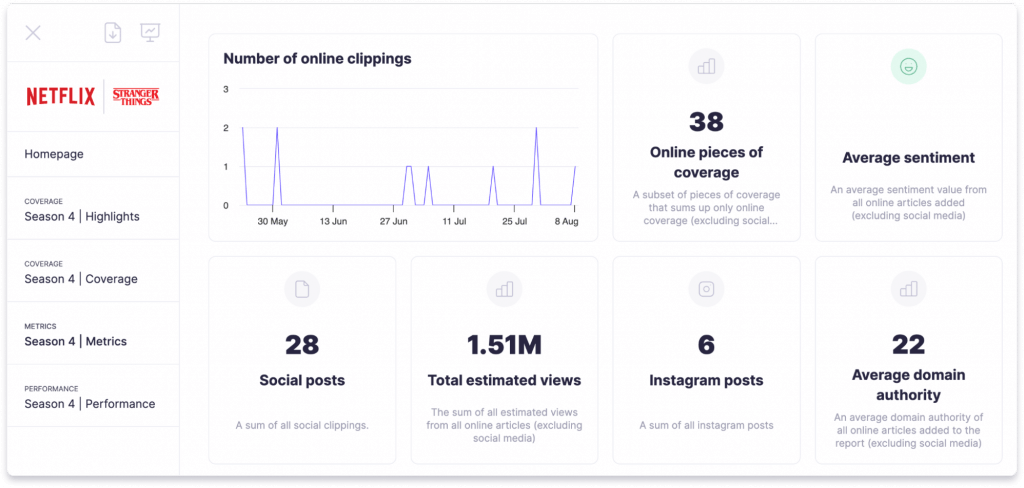
#5 Create a PR strategy based on data
📆 How often should I do this? It depends.
Depending on your goals, you might want to assess your strategy after each campaign ends or do it on a monthly or quarterly basis.
If you're just starting out, doing it more often is an effective way to assess whether or not the strategy you've put in place is working.
What's awesome about Prowly's social listening feature, is that you'll get to verify your work with cold, hard data and industry-relevant metrics.
Social listening vs. social monitoring
While many people use this term interchangeably, social listening extends further than regular social media monitoring. It involves listening in on brand mentions, keeping tabs on industry trends, customer satisfaction feedback, and so much more.
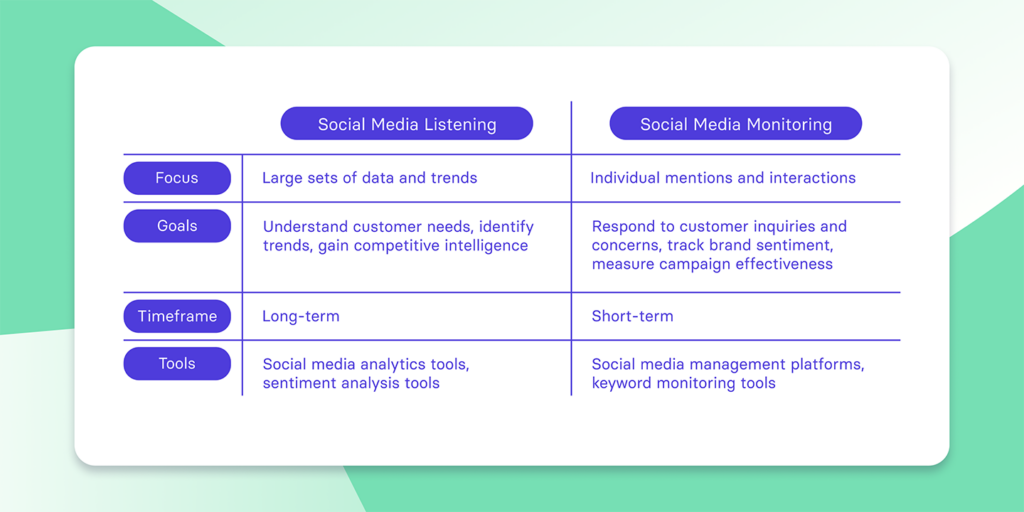
Read all about the differences between social listening and monitoring in this article.
How does social listening work?
So you've got the social listening definition already, but how does it work?
The process involves constant tracking, analyzing, and interpreting online chatter. With the help of social listening tools, you can extract important data, enabling you to make better-informed decisions and responsive public relations strategies by:
➔ Monitoring engagement
➔ Understanding sentiment
➔ Collecting data
📊 Monitoring engagement
Social listening platforms track all mentions of your brand, competitors, and specific keywords.
For example, you can set a graph to see if there is a difference in article mentions and those in social media. Maybe, after all, you'd get a better ROI in socials rather than articles.
📊 Understanding sentiment
While you may have top-tier coverage in well-known outlets (kudos to you!), there's a possibility that social listening will uncover not-so-wanted comments and sentiments across social platforms.
Think of social monitoring as a holistic way to see the world around you, from every angle.
📊 Collecting data
So, Henry, we didn't go viral this month, so what were you doing during this time?
Proving your worth is difficult without providing stakeholders and clients with data that easily shows where you have improved, and what have you achieved.
Social listening tips for PR professionals
In the ever-changing landscape of public relations, getting the best out of social media listening is crucial to navigating the digital world, implementing effective strategies, and increasing social media engagement.
Here are key tips you can use for your social listening strategy:
➔ Gain deeper insights into your audience
➔ Exclude some keywords
➔ Monitor your competitors
➔ Set social listening for key brand personas
➔ Use a social media listening tool
1️⃣ Gain deeper insights into your audience
Take your time in getting to know the people interested in your brand. Find out their preferences, behaviors, and sentiments so you can tailor communication strategies effectively, as well as demographics and online chatter.
2️⃣ Exclude some keywords
Is your search too narrow? Depending on what industry you're in, you might be better off broadening your keywords to see the full, 360 scope of the target audience.
3️⃣ Monitor your competitors
Keeping a close eye on competitors' social media activities will give you valuable insights into industry trends, their strategies, and potential opportunities to fill in the gaps they might have missed. Knowing what they're up to is key to staying ahead of the curve.
4️⃣ Set social listening for key brand personas
Don't forget to monitor people who are heavily involved in the company - founders, CEOs, or other important executives. Sometimes journalists or social media influencers can drop their names in articles or posts without tagging the brand itself.
5️⃣ Use a social media listening tool
Yes, you can do it manually by scrolling through all the social media channels but monitoring social media conversations with dedicated tools is pure gold.
With social listening tools, you'll be able to track sentiment analysis, get actionable insights, and easily spot emerging trends with straightforward data.
Be up to date with a social listening tool
The significance of social listening in today's media landscape cannot be overlooked.
From being able to analyze sentiment across different platforms, to assessing current and future strategies with data-driven decisions.
Social listening is not just a choice, but a necessity to find out and cater to the ever-evolving needs of your audience. And you can track all of this and manage many more tasks that you need for your PR success with Prowly.
